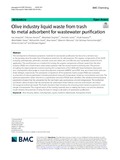Mostrar el registro sencillo del ítem
Olive industry liquid waste from trash to metal adsorbent for wastewater purifcation
| dc.creator | Ishraydeh, Isra | es_ES |
| dc.creator | Hamed, Othman | es_ES |
| dc.creator | Deghles, Abdalhadi | es_ES |
| dc.creator | Jodeh, Shehdeh | es_ES |
| dc.creator | Azzaoui, Khalil | es_ES |
| dc.creator | Hasan, Abdelfattah | es_ES |
| dc.creator | Assali, Mohyeddin | es_ES |
| dc.creator | Jaseer, Ataa | es_ES |
| dc.creator | Mansour, Waseem | es_ES |
| dc.creator | Hacıosmanoğlu, Gül Gülenay | es_ES |
| dc.creator | Can, Zehra Semra | es_ES |
| dc.creator | Algarra González, Manuel | es_ES |
| dc.date.accessioned | 2024-02-22T17:16:08Z | |
| dc.date.available | 2024-02-22T17:16:08Z | |
| dc.date.issued | 2024 | |
| dc.identifier.citation | Ishraydeh, I., Hamed, O., Deghles, A., Jodeh, S., Azzaoui, K., Hasan, A., Assali, M., Jaseer, A., Mansour, W., Hacıosmanoğlu, G. G., Can, Z. S., & Algarra, M. (2024). Olive industry liquid waste from trash to metal adsorbent for wastewater purification. BMC Chemistry, 18(1), 4. https://doi.org/10.1186/s13065-023-01104-z | en |
| dc.identifier.issn | 2661-801X | |
| dc.identifier.uri | https://hdl.handle.net/2454/47541 | |
| dc.description.abstract | The development of biobased polymeric materials for wastewater purification has become a demand due to the growing need for water free of hazardous metal ions for safe purposes. The organic components of the OLLW including carbohydrates, phenolics, aromatic acids and others are cost-effective and sustainable choices for this application. This work focuses on a method for turning the organic components of liquid waste from the olive industry (OILW) into a foam-based value-added polymer that has several metal ion binding sites. The process of making the target polymers involved reacting the components of the OILW with hexamethylene diisocyante and 1,4-phnyelene diisocynate to create the polymeric materials LHMIDIC and LPDIC that are in foam forms with urethane linkages, respectively. The adsorption competence of the polymeric foams toward Pb(II) was evaluated as a function of various parameters including adsorbent dose, pH, temperature, initial ion concentration and time. The optimum parameters values that led to a quantitative removal of Pb(II) were identified. The obtained thermodynamic parameters showed that the adsorption by the two foams was spontaneous at room temperature. The isothermal and kinetic values showed that the adsorption by synthesized foams follows a second order kinetic and obeys the Langmuir isothermal model. The foams showed a high tendency for removing multi metal ions present in a real sample of wastewater. The original nature of the starting material used in making the foam, cost and the obtained results showed the potential of using the foam in a large-scale plants of wastewater purification. | en |
| dc.description.sponsorship | This work was fnancially supported for chemicals and analysis by the Higher Council for Innovation and Excellence of Palestine (HCIE) and the Scientifc and Technological Research Council of Turkey (TUBITAK). | en |
| dc.format.mimetype | application/pdf | en |
| dc.language.iso | eng | en |
| dc.publisher | BMC | en |
| dc.relation.ispartof | BMC Chemistry 2024, 18(1), 4 | en |
| dc.rights.uri | http://creativecommons.org/licenses/by/4.0/ | |
| dc.subject | Olive industry | en |
| dc.subject | Waste | en |
| dc.subject | Carbohydrates | en |
| dc.subject | Lignin | en |
| dc.subject | Isotherm | en |
| dc.subject | Wastewater | en |
| dc.subject | Adsorption | en |
| dc.subject | Kinetic | en |
| dc.title | Olive industry liquid waste from trash to metal adsorbent for wastewater purifcation | en |
| dc.type | Artículo / Artikulua | es |
| dc.type | info:eu-repo/semantics/article | en |
| dc.date.updated | 2024-02-22T16:37:38Z | |
| dc.contributor.department | Ciencias | es_ES |
| dc.contributor.department | Zientziak | eu |
| dc.contributor.department | Institute for Advanced Materials and Mathematics - INAMAT2 | en |
| dc.rights.accessRights | Acceso abierto / Sarbide irekia | es |
| dc.rights.accessRights | info:eu-repo/semantics/openAccess | en |
| dc.identifier.doi | 10.1186/s13065-023-01104-z | |
| dc.relation.publisherversion | https://doi.org/10.1186/s13065-023-01104-z | |
| dc.type.version | Versión publicada / Argitaratu den bertsioa | es |
| dc.type.version | info:eu-repo/semantics/publishedVersion | en |



